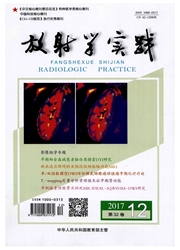

 中文摘要:
中文摘要:
目的:运用动态钆增强MR成像技术,评价正常股骨头骨骺及髋关节外展固定体位时股骨头骨骺的不同解剖区域的血供特征。方法:此研究包括13例2周龄乳猪。正常骨骺组6例,双髋关节取自然体位行MR扫描;外展固定组7例,双髋关节取极度外展固定体位2h,行MR扫描。主要MR扫描序列为钆增强动态MR成像,运用时间分辨力为3s的SPGR技术,在静脉注射钆之前、注射过程中及之后连续扫描,全部成像时间约4~5min。计算在不同体位动态钆增强MRI图像上股骨头骨骺各个解剖区域在不同时间的增强率,并与相应组织学发现作时照研究。结果:在自然体位组,海绵状骨松质的增强率最高(P〈0.001),生长板与海绵状骨松质强化快慢之间差异无显著性意义。在外展固定组,生长板的强化速度较海绵状骨松质慢((P〈0.05),生长板和骨骺软骨的增强率均较自然体位时明显减低(P〈0.05)。结论:动态钆增强MRI能显示正常以及血供障碍时骨骺不同解剖区域的血液灌注特征。
 英文摘要:
英文摘要:
Objective:To evaluate the characterization of blood perfusion of femoral head epiphysis with hips in neutral and abduction position by using dynamic gadolinium-enhanced MR imaging. Methods:Thirteen 2 week old piglets were randomly assigned into either hips with neutral position (six piglets) or with abduction position (seven piglets). Dynamic Gd-enhanced imaging was performed in bilateral hips. In group with abduction hips, maximal bilateral hip abduction was lasted for two hours and MRI was performed. Results:For dynamic Gd-enhanced imaging, spoiled gradient-recalled echo images with a temporal resolution of 3.0s were performed before,during,and after the injection of gadolinium,and a total of 96 images were obtained. The enhancement ratios in different tissues regions were evaluated and correlated with histological findings. Results:In group with neutral position, the enhancement ratio of metaphyseal spongiosa was greatest compared to those of all other anatomic regions (P〈0. 001). No significant differences in enhancement speed between physeal cartilage and spongiosa was found. In group with abduction position, physeal cartilage enhance'd more slowly than spongiosa (P〈0.05), The enhancement ratios of physeal and epiphyseal cartilage in abduction position were lower than those in neutral position. Conclusion:Dynamic gadolinium-enhanced MR imaging can characterize the blood perfusion in the various anatomic regions of growing femoral head in either normal or blood occlusion.
 同期刊论文项目
同期刊论文项目
 同项目期刊论文
同项目期刊论文
 期刊信息
期刊信息
